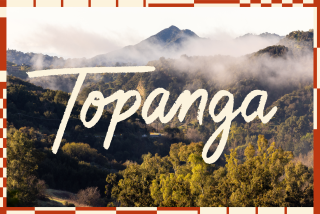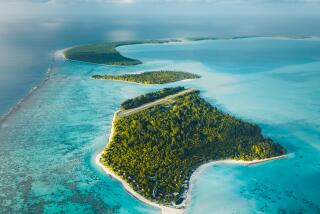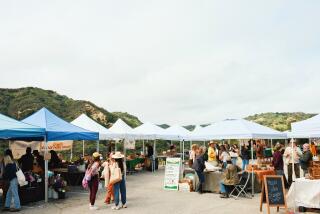Fantasy Islands : It’s Hard to Find an Escape More Remote Than Any of These South Pacific Outposts. With the Current Transpacific Air-Fare Bargains, There’s No Better Time to Go. : Tonga: Polynesia’s Last Kingdom
NUKU'ALOFA, Tonga — Flying in from Fiji, our fellow passengers included Tonga’s crown prince and princess, a visiting U.S. diplomat who’d seen coups in three countries, and a bleary-eyed Chinese man who boarded the 8 a.m. flight in a starched white dinner jacket and black velvet dancing pumps.
When we landed, we were met on the runway by His Majesty the King of Tonga, the kind and corpulent King Taufa’ahau Tupou IV--Knight Grand Cross of the Royal Victorian Order, Knight Grand Cross of the Order of St. Michael and St. George, Knight of the British Empire, etc.,etc.--and his royal Chevy van.
Walking across a hastily laid red carpet, the prince and princess embraced their regal dad. The dapper party-goer, Tonga’s honorary consul in Hong Kong, followed meekly behind. The American headed out to check local coup rumors. And after a few days’ work, my wife, Maggy, and I chartered a 38-foot sloop and island-hopped across one of my favorite countries in the world.
The Kingdom of Tonga, happily, is not for everyone. First, getting to Tonga isn’t easy: The 170 or so mostly uninhabited coral atolls and volcanic islands are sprinkled deep in the South Pacific; Samoa is 500 miles north, Fiji is 500 miles northwest. Only a few thousand tourists make it each year, mostly visiting yachtsmen.
Second, tourist facilities and sights are minimal. The best hotel is the three-story, motel-like International Dateline. Tonga has no golf, no jet skis, no CNN (or any TV, for that matter) and no traffic lights. There are only 23 rental cars, and pigs wander down the road at will. Visitors are encouraged to go to church--nearly everything else is closed or illegal on Sundays anyway.
Other than watching the 300-plus-pound king exercise--hidden behind thick black goggles, the 73-year-old monarch peddles a fragile black bicycle around a stadium each Monday, Wednesday and Friday, and rows a small wooden skiff around the harbor on Tuesday, Thursday and Saturday--tourist attractions are few.
The Victorian, gingerbread-fronted Royal Palace looks like a summer cottage in Cape May, N.J. The Royal Tombs, two dozen stone-terraced burial mounds, and an ancient Stonehenge-like coral structure apparently once used for the solstice, are underwhelming. Only a surf-battered coastline lives up to its billing. Each crashing wave sends geysers spouting skyward through blowholes in the coral. When we visited during high tide last September, hundreds of roaring plumes laced the air. Misty rainbows were everywhere. Old Faithful will never look the same.
But Tonga is Polynesia’s last kingdom, and the only Pacific nation never colonized or brought under foreign rule. Nor has it been invaded by Holiday Inn, tacky Kon Tiki-style restaurants, or buses of camera-toting tourists.
Tonga is the unspoiled remnant of the South Pacific of the past, with the same pristine white-sand beaches, fringed palms and friendly people that characterize other archipelagos, but without $250-per-night (and up) waterfront hotel rooms and a constant feeling that you are more a marketing target than a person.
Indeed, Tonga may be unique of the dozens of Pacific islands visited by Capt. James Cook, the intrepid 18th-Century English explorer, in keeping its traditional culture essentially intact.
Cook clearly was smitten by what he called the Friendly Islands. “None of the most civilized nations have ever exceeded these islanders in the great order and regularity maintained on every occasion, in ready and submissive compliance with the commands of their chiefs, and in the perfect harmony that subsists among all ranks,” he wrote after his third and last visit in 1777.
Other accounts say local cannibals wanted to cook Cook, but no matter. A small plaque, half-hidden under an ovava tree where he supposedly rested, marks his landfall on Tongatapu, the main island. (Nothing marks the infamous mutiny on the HMS Bounty, which occurred in Tongan waters 12 years later.) A Galapagos tortoise that Cook left as a farewell gift lived until 1966, and is stuffed and on display in a tiny museum.
Hereditary kings already had ruled Tonga for nine centuries when Wesleyan Methodist missionaries arrived in 1822. They soon baptized a chief, who became King George Tupou I. He ended slavery and cannibalism, established a written constitution and successfully fended off Western colonial powers who were then carving up the Pacific. His British-born pastor and premier, the Rev. Shirley Baker, wasn’t so lucky. A victim of politics, he was deported to Fiji, where a wooden fork reputedly used to eat him is displayed in a museum.
The current king rules with the help of 33 nobles--hereditary chiefs who control most of the land, economy and government. There are no political parties or unions. There is also no hunger; there is good health care and nearly universal literacy. Despite grumbling over alleged abuses of power, the king still commands considerable respect among his 105,000 subjects.
Anxious to know more, I called on Noble Fusitua, speaker of the Tongan legislature and one of the most powerful nobles. His home sits behind the palace with a comfortable open-air veranda and a garden of mango and banana trees. He’d just come from a privy council session, and wore a knee-length gray cloth skirt, with a traditional woven grass mat around his belly. His family is from Niuafo’ou, better known to Pacific sailors as Tin Can Island. Until a grass airstrip was built, treacherous reefs kept mailboats from approaching the tiny island. So all mail was sealed in biscuit tins and handed to local swimmers to ferry ashore. I asked about the king.
“The king is not only a political figure,” he replied. “He’s not only the head of state. He’s the head of a family. And that’s how he’s regarded. The nobility, the head of the church, those are the senior members of the family. And down the hierarchy to the heads of villages and the heads of households. That is Tongan society. And it has lasted 1,000 years. If it can withstand the test of so many years, there must be something in it.”
Tongan society was on display when we flew to Neiafu, in the northern Vava’u islands, several days later. The king had arrived for an agricultural fair and the town was on best behavior. Everyone wore ta’ovalas, the woven belly mats that are a sign of respect. The oldest, most tattered mats are the most prized. Older women wore long black, tent-like dresses, with lacy tassels dangling off thick fiber belts. And thin is not in here. By some accounts, Tongans are the biggest people on earth.
The next day, hundreds of families politely waited in the sun as His Majesty, protected by a parasol, solemnly judged giant yams, watched dozens of young dancers (all children learn traditional dances in school), and accepted gifts of tapa, coarse painted cloth made from mulberry bark. Lunch was 300 roast suckling pigs laid out in two long rows, surrounded by tons of fruit.
Vava’u’s thickly wooded volcanic islands resemble parts of the Caribbean, but without the prices or hustle. We had arranged a 10-day bareboat charter from The Moorings, a reputable international company with a base in Neiafu. After briefing us on the charts, manager Tom Watson encouraged us to visit the villages.
“Tongan people don’t understand boisterous activity,” he said. “They understand smiles, gentle words and genuine interest. Go in there acting like you own the place and no one will talk to you. Go in politely, ask questions and someone probably will invite you home.”
He also mentioned a feast at a nearby island beach the next night. After rowing ashore, we joined several other yacht crews sitting cross-legged with local men on a carpet of long banana leaves. A bare-chested old man with gray hair to his shoulders and a red sarong silently offered a coconut shell full of kava, a drink made from pepper shrub roots, in both hands. It tasted bitter and quickly numbed my lips. When I passed the empty shell back, he filled it for the next man in a dignified ritual.
Soon, an earthen oven called an umu produced dozens of leaf-wrapped sacks of roasted octopus and lobster, grilled lagoon fish, suckling pig, sweet clams and other delicacies. As the evening sky turned orange and magenta, two dozen young girls performed ceremonial dances--akin to Tahitian but more prudish--to two guitars and spirited clapping and singing. The dancers wore tight sarongs adorned with flowers, feathers and shells, and their bodies glistened with coconut oil. I followed the lead of local men and pasted Tongan dollars to their arms and shoulders.
For the next few days we sailed among Vava’u’s few dozen islands, most nights anchoring off deserted white-sand beaches and grilling steaks or fish on a barbecue. Navigation is mostly by eyeball: As depths change, water turns from azure to sapphire to turquoise. We spent one afternoon simply tacking back and forth under steep windy cliffs after spotting a humpback whale spout, wave his flukes and dive.
When one day dawned unusually cold and rainy, I used the shipboard radio to call Mark Field, a former San Diegan who with his wife has set up a small scuba shop on a beach outside Neiafu. He roared alongside in his speedboat early the next morning and delivered scuba equipment.
For three days, he and I dived virtually alone in crystal-clear waters while Maggy read, swam and relaxed. A highlight for me was cave-diving at 40 feet for white-tipped sharks. Granted, this is not everyone’s idea of fun, but we had already explored a sunken copra steamer, lush underwater canyons and dramatic deep-water dropoffs lined with grouper, barracuda and tuna. The cost: only $150 for six dives, not including equipment.
Another day, we took the dinghy into a spot called Swallow’s Cave. Thousands of birds nest in the cathedral-like chamber, and dazzling shafts of sunlight seemed to set the red rocks ablaze and turn the water iridescent blue. More difficult to find is Mariner’s Cave. The entrance is underwater, marked only by a palm tree growing out of the cliff. Once found, a snorkler can dive into the peaceful grotto. Legend says a young chief hid his sweetheart inside when local feuds raged.
When Sunday came, my wife and I did as Tongans do: We went to church. We had little choice since we had anchored off Nuapapa island. Village gongs and hollow logs were beat at 6 a.m. and soon a young boy serenaded us from shore with “Michael, Row Your Boat Ashore.” When I stumbled above deck, he smiled and waved.
We ate breakfast, dressed and rowed ashore. William, 13, took us each by the hand for a tour. Matamaha village, he said, had 200 people, 10 horses, 4 cows and piglets by the dozen. A few homes were made of cement, but most were traditional thatch fales (FAH-lays), which look like ovoid haystacks with doors, scattered under palm and breadfruit trees. Animals mostly run loose, so gardens are carefully fenced. A locked booth with a solar panel and antennae turned out to be the island’s only telephone. “You can call America,” William said proudly.
The gongs rang again at 9:30. With four churches in the village, my wife opted for the largest, a Methodist church. Several giggling girls in prim white dresses grabbed her hand. I followed William to a small wooden building with coral steps and no glass in the windows. It was his home, he said, and his father was the minister--a Mormon.
His family welcomed me. They sang and prayed for 40 minutes and then invited me to stay for lunch. Down below, the town’s larger choirs were belting out divine harmonies that echoed across the reef. An hour or so later, as we sailed away, they were still singing.
GUIDEBOOK
Adventures in Tonga
Getting there: Except for Sunday, there are daily flights to Nuku’alofa from Auckland, New Zealand, on either Royal Tongan Airlines, Polynesian Airlines or Air New Zealand (the trip takes about three hours). Air New Zealand currently has a bargain fare for $564 round trip from LAX to Auckland, plus $200 more for a stopover in Tonga. Hawaiian Airlines has two flights a week from Honolulu via Pago Pago in American Samoa. Most flights inside the country are on Royal Tongan Airlines. Those with more time should consider inter-island ferries. The MV “Olovaha” goes weekly from Nuku’alofa to Vava’u for about $50.
When to go: The rainy season runs from January to April, but even then, a week or more may pass without rain.
Shopping: Tonga is a duty-free port. It’s also renown as one of the best places in the Pacific for finely woven baskets, mats and tapa, a coarse cloth made from mulberry bark and painted with traditional designs.
Where to stay: Tonga offers comfortable, clean and often charming accommodations, but nothing that meets international five-star standards. Nuku’alofa, the capital, has several hotels and two dozen or so guest houses.
The International Dateline, the best-known hotel, is a short walk along the seafront from the Royal Palace. It has 76 rooms and a pool; rates range from $67 to $100. The 60-room Ramanlal Hotel downtown seems always under construction, but has drawn a following among businessmen, partly for the busy garden bar and nightclub. Single rooms go for $69, a suite for $175. Unless you mind sharing bathrooms, the Beach House, a guest house with a large veranda overlooking the harbor, looks more inviting. Figure $15 for a single, $25 for a double.
Several resorts on private islands are a short boat ride outside the capital. The Pangaimotu Island Resort, the closest and most popular, is on a small island in a marine reserve. Shelling is good and a shipwreck for divers is just off the beach. Farther out, the Fafa Island Resort offers snorkling and scuba diving; go on a day trip, or book a fale (thatch hut) for $90. The Royal Sunset Island Resort, the most up-market of the three, has 25 fales with living rooms and kitchenettes off a white-sand beach for $80 a night.
Where to eat: Restaurants are surprisingly good; we dined repeatedly on huge $4 platters of lobster thermador. Perhaps the best is the Seaview, an upscale German-run place in a home just down the waterfront from the British High Commission. We paid about $30 for a dinner for two.
For more information: Contact the Tonga Visitors Bureau, P.O. Box 37, Nuku’alofa, Kingdom of Tonga, telephone 011-676-21-733; fax 011-676-22-129.
More to Read
Sign up for The Wild
We’ll help you find the best places to hike, bike and run, as well as the perfect silent spots for meditation and yoga.
You may occasionally receive promotional content from the Los Angeles Times.







